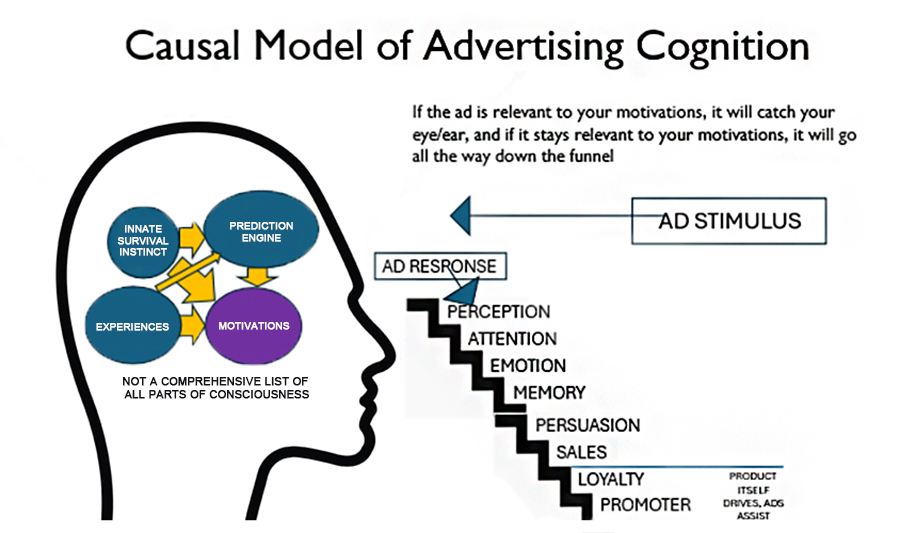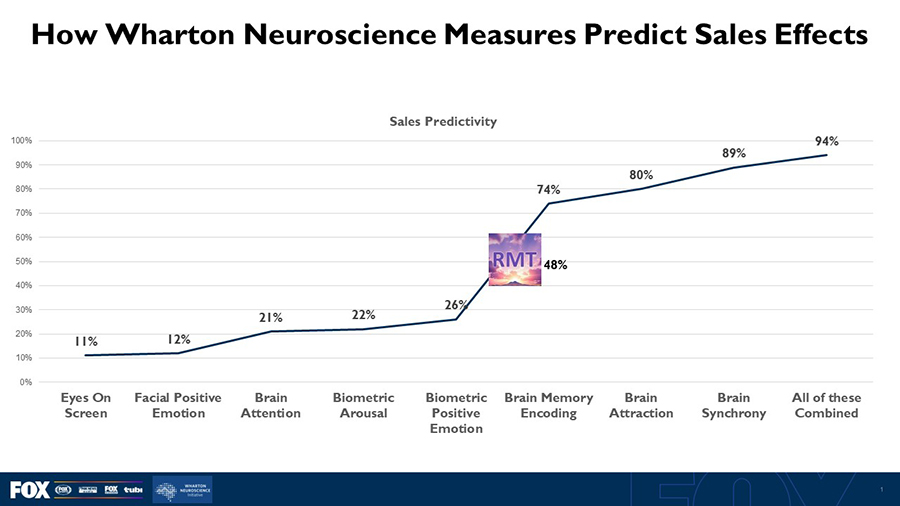A New View of the Advertising Process in the Mind

The oldest of the models was AIDA – Attention, Interest, Decision, Action. This was a perfect flavor for the rational view of the economic agents i.e. consumers at the time. It was assumed obvious that each person would make decisions based on the rational weighing of the benefits versus the costs. The industry was intrigued to find out that “emotional” and “image” ads could also have effect, and this led to pockets of creative people who would specialize in such ads.
Long before marketers woke up from this delusion that people always make decisions rationally – the term “behavioral economics” and some explanatory text was all they needed to come to their senses – the Advertising Research Foundation (ARF) found the need and opportunity to create its own model of how advertising is processed in the mind. The ARF Model was oriented to the kinds of measurements that could be taken, so every step in its Model was oriented to specific measurements the industry knew how to take.
Erwin Ephron loved to tell the story about how Alfred Politz, the first advertising research giant, argued that although Perception was unquestionably a key stage, it was not operationalizable at the time, and argued unsuccessfully to take it out. Erwin and I (and others) got to update the Model in 2003 and we changed Perception to Attention as we knew that eye tracking was already available mostly thanks to Lee Weinblatt. This was sort of a nod to Alfred.
We also added Advertising Response – interaction with advertising short of sales – since clickthrough, a term I had coined along with clickstream in the early 90s – was now a big deal by 2003. We added a lot of things including the nonlinearity of the Model i.e. things did not always have to happen in the standard sequence.
The standard sequence in 2003 was:
- Vehicle Distribution
- Vehicle Exposure
- Ad Exposure
- Attention
- Communication
- Persuasion
- Advertising Response
- Sales Response
Just prior to that, I had published a model with more steps, which Jim Spaeth, who as President of ARF had asked me to form the committee to update the ARF Model, prompted by my publication which was in the ARF’s Journal of Advertising Research (JAR), but Jim was also on the committee and he felt that 8 was the perfect number of steps to have in the Model, citing Buddha’s Noble Eightfold Path.
Daniel Kahneman, who won the Nobel Prize in Economics for his model of System1 vs. System2, is also credited with the popularization of behavioral economics in the work he began in the 1980s, although the term goes back to the 1940s.
Only a year after Kahneman won the Nobel Prize, Harvard Neuroscientist Jerry Zaltman published a book, How Consumers Think, which rocked the marketing world with the revelation that 95% of consumer decision making is subconscious. To most marketers, the word “subconscious” means “emotional” and is the “opposite” of “rational”, which is an oversimplified mishmash of category errors. “Orthodoxy first” neuroscientists sneer at the term “subconscious” and prefer “below the level of conscious awareness”.
Today neuroscience has come to see Kahneman’s “two systems” as being more of a continuum as opposed to two polar categories, fast vs. slow thinking being more of a phenomenon than two separate systems, and typical mind usage being more of a combination of both the slow and fast thinking aspects.
Karl Friston has captured the minds of neuroscientists with his theory of active inferencing, in which a prediction engine exists within the brain which makes most of the decisions leading to actions (behavior). This echoes Zaltman by translating “subconscious” into “inference engine” which sits better within the scientific culture as it has come to be. (I published Mind Magic in 1976 which describes a “robot” part of oneself which makes predictions and rules most of our actions. I’m happy that Friston has backed me up in that.)
Because the vast majority of marketers have never seen the importance of clarifying their understandings of how the human mind works with regard to advertising, it is their tendency to oversimplify, lump together things they don’t understand, and try to reduce the number of things they need to think about. This is what enabled Attention to become perceived as just about the only “qualitative” variable one needs to think about.
It would have taken only a few seconds of talking with an intelligent five-year-old to come to the realization that almost all of us have had the experience of paying attention to a specific ad and never even thinking for one second about buying the product advertised.
The ARF Model of course even without having to explain it in detail, implies merely from the list of 8 levels above, that after one gets Attention you still have to get Communication and Persuasion before you are going to achieve any kind of behavioral response. If you read the ARF 2003 Model paper you will see that nonlinearity is mentioned as a possibility, and nothing is absolutely ruled out, so it is possible you can sell something with an ad even if you skipped some stage in the Model – it’s just highly unlikely.
Putting together the latest work of Friston and everyone else in the field, here is a new Model which emerges.

Motivations are formed within us by our experiences, by our biological instincts, and by a prediction engine that seeks to reduce surprise. For the moment let us identify the prediction engine as a part of what has heretofore been called the subconscious mind. Let us allow for the prediction engine also being able to bring specific feelings, thoughts, impulses, and ideas into the conscious mind. The prediction engine is therefore analogous to a bio-AI. Unlike the conscious mind which flits from this to that and is not constantly aware of all previous experiences, the bio-AI specializes in keeping all of that data front and center, instantly and constantly accessible. It evolved for our survival protection. It warns us when it detects the probability of danger based on reams of data we have in our experience bank but at the moment we don’t consciously realize are relevant.
As Friston and virtually every neuroscientist and psychologist point out, motivations (also known as desires, goals, need states, drives, drivers, objectives, etc.) are the things we want most out of life, and everything we do hinges upon these “targeted outcomes”. These are our Rubicon, our Philosopher’s Stone, our compass, our summum bonum. This is why I have depicted Motivations in a purple ellipse, because they are the central ruling features of the entire process, everything else is derived from them and exists to serve them.
Motivations drive our actions, including whether we are drawn to a screen by something, therefore motivations are in charge at every stage of the ad response. Before conscious perception, apperception occurs which is subconscious perception: the inference engine sees the stimulus. If the engine categorizes the stimulus as relevant to the motivations, the conscious mind will be caused to notice the stimulus. Motivations precede Attention, motivations even precede Perception. This was left out of the ARF Model. What we see in the new Model proposed above, is that Motivations have been brought into the picture, and if the Inference Engine “gate” opens, the cascade of advertising responses can begin to occur. If the ad succeeds it will hold the active conscious attention and carry it along to feel attraction, liking, positive emotion, and these experiences will be input into memory. If certain attributes of the brand that had not in the past been strongly associated with the individual’s motivations, but now those brand attributes are linked more solidly to those motivations, Value Signals (abbreviated by neuroscientists as VS) will be detected in the brain. Hundreds of different VS have been identified in the brain. This is a manifestation of how the brain calculates during choice behavior. This may include Persuasion, the increase in the valuation of the brand. But if the perceived cost (including time and inconvenience costs) exceeds the perceived benefit, different Value Signals will still occur, but the result will not be Persuasion and there will be no buying action taken.
In the work I’ve been privileged to do with FOX and Wharton Neuroscience, we’ve investigated the degree to which RMT Resonance predicts buying signals in the brain (EEG memory encoding, approach, and synchrony). RMT Resonance is the quantified psychological similarity between an ad and a media context in terms of hundreds of motivational dimensions empirically determined to be the drivers of choice behavior. RMT(Research Measurement Technologies) is a company I co-founded with Bill McKenna and Skip Cornelius and its predecessor Next Century Media (NCM) was an early user of machine learning and AI. The RMT model is not a Large Language Model (LLM) but is a semantic Deep Learning Model (DLM). We found that these RMT metrics were significantly predictive of these EEG buying signals.
When Michael Platt, Wharton Neuroscience Initiative Director, one of the founders of Neuroeconomics and an inventor of home-use EEG systems, saw the RMT results he wrote:
“Given the alignment so far it looks like these may prove to be, dare I say, universal predictors (which resonates with the ability to predict out-of-sample sales at high levels).”
When added to the plot of other sales predictive metrics RMT falls right below the EEG measures (the 0.48 Adjusted R2 ability to predict sales comes from the ARF Cognition Council study which used six years of IRI sales data):

RMT has decided to change the name “DriverTags” (the 265 most granular motivational variables) to “Value Signals” because it appears that these 265 meanings could well correspond to the hundreds of different valuation signals in the brain found by neuroscientists using fMRI.
Posted at MediaVillage through the Thought Leadership self-publishing platform.
Click the social buttons to share this story with colleagues and friends.
The opinions expressed here are the author's views and do not necessarily represent the views of MediaVillage.org/MyersBizNet.


